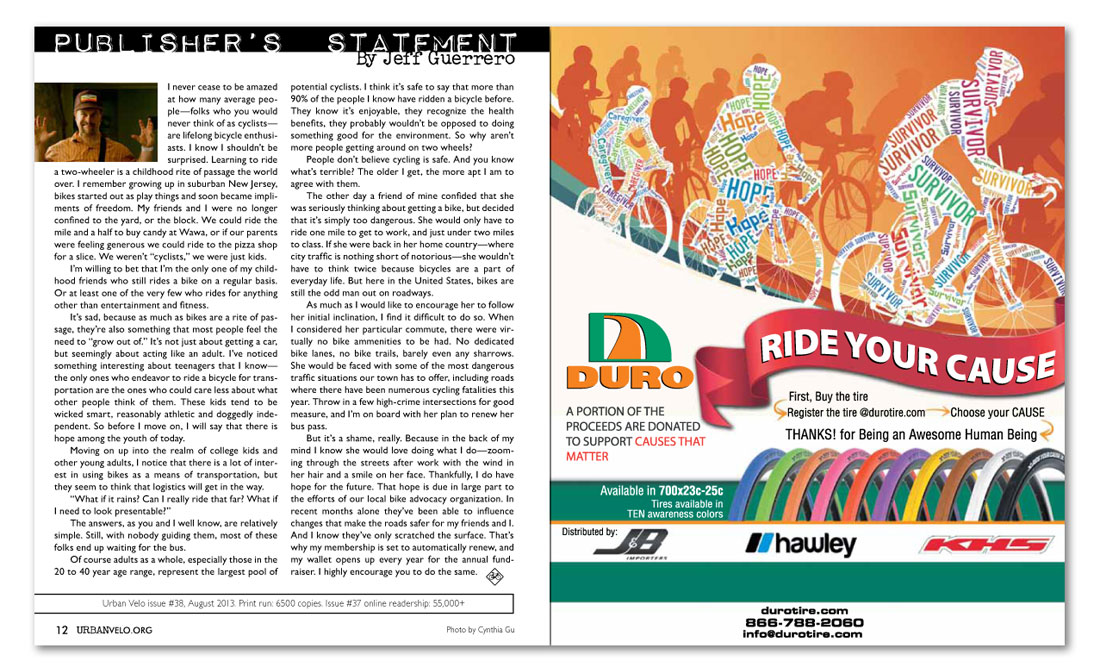


Publisher's Statement
I never cease to be amazed at how many average people—folks who you would never think of as cyclists—are lifelong bicycle enthusiasts. I know I shouldn’t be surprised. Learning to ride a two-wheeler is a childhood rite of passage the world over. I remember growing up in suburban New Jersey, bikes started out as play things and soon became impliments of freedom. My friends and I were no longer confined to the yard, or the block. We could ride the mile and a half to buy candy at Wawa, or if our parents were feeling generous we could ride to the pizza shop for a slice. We weren’t “cyclists,” we were just kids.
I’m willing to bet that I’m the only one of my childhood friends who still rides a bike on a regular basis. Or at least one of the very few who rides for anything other than entertainment and fitness.
It’s sad, because as much as bikes are a rite of passage, they’re also something that most people feel the need to “grow out of.” It’s not just about getting a car, but seemingly about acting like an adult. I’ve noticed something interesting about teenagers that I know—the only ones who endeavor to ride a bicycle for transportation are the ones who could care less about what other people think of them. These kids tend to be wicked smart, reasonably athletic and doggedly independent. So before I move on, I will say that there is hope among the youth of today.
Moving on up into the realm of college kids and other young adults, I notice that there is a lot of interest in using bikes as a means of transportation, but they seem to think that logistics will get in the way.
“What if it rains? Can I really ride that far? What if I need to look presentable?”
The answers, as you and I well know, are relatively simple. Still, with nobody guiding them, most of these folks end up waiting for the bus.
Of course adults as a whole, especially those in the 20 to 40 year age range, represent the largest pool of potential cyclists. I think it’s safe to say that more than 90% of the people I know have ridden a bicycle before. They know it’s enjoyable, they recognize the health benefits, they probably wouldn’t be opposed to doing something good for the environment. So why aren’t more people getting around on two wheels?
People don’t believe cycling is safe. And you know what’s terrible? The older I get, the more apt I am to agree with them.
The other day a friend of mine confided that she was seriously thinking about getting a bike, but decided that it’s simply too dangerous. She would only have to ride one mile to get to work, and just under two miles to class. If she were back in her home country—where city traffic is nothing short of notorious—she wouldn’t have to think twice because bicycles are a part of everyday life. But here in the United States, bikes are still the odd man out on roadways.
As much as I would like to encourage her to follow her initial inclination, I find it difficult to do so. When I considered her particular commute, there were virtually no bike ammenities to be had. No dedicated bike lanes, no bike trails, barely even any sharrows. She would be faced with some of the most dangerous traffic situations our town has to offer, including roads where there have been numerous cycling fatalities this year. Throw in a few high-crime intersections for good measure, and I’m on board with her plan to renew her bus pass.
But it’s a shame, really. Because in the back of my mind I know she would love doing what I do—zooming through the streets after work with the wind in her hair and a smile on her face. Thankfully, I do have hope for the future. That hope is due in large part to the efforts of our local bike advocacy organization. In recent months alone they’ve been able to influence changes that make the roads safer for my friends and I. And I know they’ve only scratched the surface. That’s why my membership is set to automatically renew, and my wallet opens up every year for the annual fundraiser. I highly encourage you to do the same.